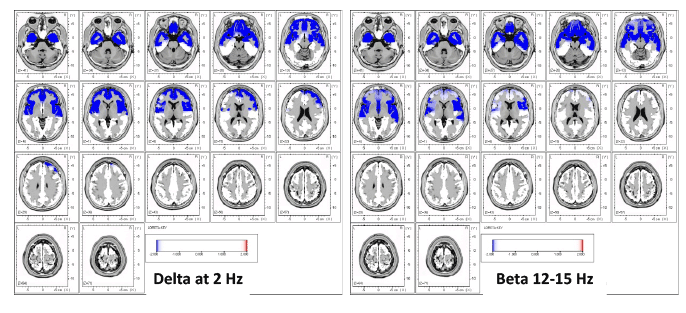QEEG
Electroencephalogram or EEG records surface brain electrical activity, and quantified electroencephalogram or qEEG with LORETA source analysis of the qEEG signal uses complex math to localize brain activity deeper in the brain down to a millisecond time scale.[1] It can be thought of as a real-time readout of brain function that lets you see what different areas of the brain are doing.[1]
Theory[edit | edit source]
Evidence[edit | edit source]
Zinn et al. (2016) reported:
Our case study confirmed the pattern of dysregulation in the cortex reviewed in the introduction. Furthermore, since both periods of phase shift/lock durations were found to be significantly shorter, that might contribute to an increased rate of phase reset, also seen in our data. Phase reset deregulation--phase locking periods being too brief and phase reset happening too often—appear to be consistent with the associated lower rate of information processing and reaction times found in the ME and CFS literature. These deregulated states represent the brain during nonoptimal functioning, rendering it inefficient for most types of information processing functioning, whether it is executive functioning, memory, perceptual reasoning or information processing speed. When phase lock is significantly less than normal, as in this data set, the ability of the brain to sustain commitment of resources to mediate different functions is severely compromised. Phase shift duration in this data is also hypoactive, meaning that significantly less neurons are being recruited to perform a function than normal. The results here indicate slowed verbal comprehension, executive functions, perceptual reasoning, processing speed and memory, the sum total of which is known as cognitive impairment.[1]

ME/CFS[edit | edit source]
- Brian Vastag was able to prove with qEEG and cognitive tests he had "significant problems with visual perception and analysis, scanning speed, attention, visual motor coordination, motor and mental speed, memory, and verbal fluency" winning his long term disability (LTD) claim.[2]
Cost and availability[edit | edit source]
Notable studies[edit | edit source]
- 2016, qEEG / LORETA in Assessment of Neurocognitive Impairment in a Patient with Chronic Fatigue Syndrome: A Case Report[1] - (Full text)
See also[edit | edit source]
Learn more[edit | edit source]
- Wikipedia - Quantitative electroencephalography
- 2016, Case Study: "Brain Fog" in CFS can be seen in qEEG/Loreta - #MEAction Network
- 2018, Study Identifies the Types of Cognitive Dysfunction That Are Most Prevalent in Fibromyalgia
- Jun 4, 2018, Victory For ME Disability Claim – U.S. Court Upholds Plaintiff's Lawsuit After Being Denied Disability
References[edit | edit source]
- ↑ 1.0 1.1 1.2 1.3 1.4 Zinn, ML; Zinn, Mark A.; Jason, Leonard (2016). "qEEG / LORETA in Assessment of Neurocognitive Impairment in a Patient with Chronic Fatigue Syndrome: A Case Report". Clin Res Open Access. 2 (1). doi:10.16966/2469-6714.110.
- ↑ Tillman, Adriane (June 4, 2018). "Victory for ME Disability Claim - U.S. Court Upholds Plaintiff's Lawsuit After Being Denied Disability". #MEAction. Retrieved February 2, 2019.

